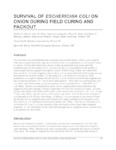Por favor, use este identificador para citar o enlazar este ítem:
http://www.alice.cnptia.embrapa.br/alice/handle/doc/970551Registro completo de metadatos
| Campo DC | Valor | Lengua/Idioma |
|---|---|---|
| dc.contributor.author | SHOCK, C. C. | pt_BR |
| dc.contributor.author | PINTO, J. M. | pt_BR |
| dc.contributor.author | LAUBACHER, T. A. | pt_BR |
| dc.contributor.author | ROSS, R. D. | pt_BR |
| dc.contributor.author | MAHONY, A. C. | pt_BR |
| dc.contributor.author | KREEFT, H. | pt_BR |
| dc.contributor.author | SHOCK, B. M. | pt_BR |
| dc.date.accessioned | 2017-07-19T00:05:04Z | - |
| dc.date.available | 2017-07-19T00:05:04Z | - |
| dc.date.created | 2013-11-06 | pt_BR |
| dc.date.issued | 2013 | pt_BR |
| dc.identifier.citation | In: SHOCK, C. C. (Ed.). Preliminary studies on Escherichia coli and onion. Ontário: Oregon State University, Malheur Experiment Station, 2013. | pt_BR |
| dc.identifier.uri | http://www.alice.cnptia.embrapa.br/alice/handle/doc/970551 | pt_BR |
| dc.description | The Food and Drug administration has expressed concern that Onions (Allium cepa) irrigated with water contaminated with high rates of Escherichia coli could harbor E. coli on their surface or interior. On the other hand, since onions contain antimicrobial compounds and field conditions may not be conducive to E. coli survival, the E. coli population on the surface of onions might become negligible through the course of field curing. Further, the relationship between the E. coli in the irrigation water to the E. coli on onion bulbs after field curing, harvest, and packout has not been studied. To determine if E. coli should be of concern in onion production, we sought to measure the die-off of E. coli on onions between the last irrigation and harvest and the presence of E. coli on onions after packout. Well water was tested and had no E. coli; ditch water intentionally run across a pasture prior to use had 218 to > 2400 MPN of E. coli/100ml. Onions were sampled from those furrow irrigated (ditch water) and those drip irrigated (well water) starting at lifting 3 September 2013 for four consecutive weeks. At 0 and 28 days after lifting, both interior and exterior of the onions were tested for E. coli. At 7, 14, and 21 days after lifting, only the exterior of the onions was tested. None of the onions contained E. coli internally at 0 or 28 days after lifting. At lifting E. coli was present on the exterior of both the drip and furrow irrigated onions and seemed to be largely unrelated to the irrigation water. The exterior E. coli contamination decreased rapidly after lifting. After harvest and packout on 14 October 2013, no E. coli was detected on the onion bulb exteriors from either irrigation treatment. E. coli introduced into the onion field through furrow irrigation was not present on or in the packed out onion bulbs. | pt_BR |
| dc.format | (OSU. Special Report, Ext/CrS, 148). | pt_BR |
| dc.language.iso | eng | eng |
| dc.rights | openAccess | eng |
| dc.subject | Onion | pt_BR |
| dc.title | Survival of Escherichia coli on onion during field curing and packout. | pt_BR |
| dc.type | Parte de livro | pt_BR |
| dc.date.updated | 2017-07-19T00:05:04Z | pt_BR |
| dc.subject.thesagro | Cebola | pt_BR |
| dc.subject.thesagro | Irrigação | pt_BR |
| dc.subject.thesagro | Allium Cepa | pt_BR |
| dc.subject.thesagro | Bactéria | pt_BR |
| dc.subject.thesagro | Contaminação | pt_BR |
| dc.subject.thesagro | Escherichia Coli | pt_BR |
| dc.format.extent2 | p. 18-27. | pt_BR |
| riaa.ainfo.id | 970551 | pt_BR |
| riaa.ainfo.lastupdate | 2017-07-18 | pt_BR |
| dc.contributor.institution | JOSE MARIA PINTO, CPATSA. | pt_BR |
| Aparece en las colecciones: | Capítulo em livro científico (CPATSA)  | |
Ficheros en este ítem:
| Fichero | Descripción | Tamaño | Formato | |
|---|---|---|---|---|
| Pinto2.pdf | 396,21 kB | Adobe PDF |  Visualizar/Abrir |









